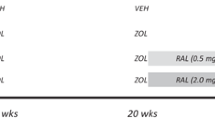Abstract
Bisphosphonates (BPs) slow bone loss by reducing initiation of new basic multicellular units (BMUs). Whether or not BPs simply prevent osteoclasts from initiating new BMUs that resorb bone or also reduce the amount of bone they resorb at the BMU level is not clear. The goal of this study was to determine the effects of BPs on three morphological parameters of individual BMUs, resorption depth (Rs.De), area (Rs.Ar), and width (Rs.Wi). After 1 year of treatment with vehicle (VEH), alendronate (ALN; 0.10, 0.20, or 1.00 mg/kg/day), or risedronate (RIS; 0.05, 0.10, or 0.50 mg/kg/day), resorption cavity morphology was assessed in vertebral trabecular bone of beagle dogs by histology. Animals treated with ALN or RIS at the doses representing those used to treat postmenopausal osteoporosis (0.20 and 0.10 mg/kg/day, respectively) had significantly lower Rs.Ar (−27%) and Rs.Wi (−17%), with no difference in Rs.De, compared to VEH-treated controls. Low doses of ALN and RIS did not affect any parameters, whereas higher doses resulted in similar changes to those of the clinical dose. There were no significant differences in the resorption cavity measures between RIS and ALN at any of the dose equivalents. These results highlight the importance of examining parameters beyond erosion depth for assessment of resorption parameters. Furthermore, these results suggest that in addition to the well-known effects of BPs on reducing the number of active BMUs, these drugs also reduce the activity of osteoclasts at the individual BMU level at doses at and above those used clinically for the treatment of postmenopausal osteoporosis.


Similar content being viewed by others
References
Russell RG, Watts NB, Ebetino FH, Rogers MJ (2008) Mechanisms of action of bisphosphonates: similarities and differences and their potential influence on clinical efficacy. Osteoporos Int 19:733–759
Rodan GA, Fleisch HA (1996) Bisphosphonates: mechanisms of action. J Clin Invest 97:2692–2696
Boyce RW, Paddock CL, Gleason JR, Sletsema WK, Eriksen EF (1995) The effects of risedronate on canine cancellous bone remodeling: three-dimensional kinetic reconstruction of the remodeling site. J Bone Miner Res 10:211–221
Cohen-Solal ME, Shih MS, Lundy MW, Parfitt AM (1991) A new method for measuring cancellous bone erosion depth: application to the cellular mechanisms of bone loss in postmenopausal osteoporosis. J Bone Miner Res 6:1331–1338
Roux C, Ravaud P, Cohen-Solal M, de Vernejoul MC, Guillemant S, Cherruau B, Delmas P, Dougados M, Amor B (1994) Biologic, histologic and densitometric effects of oral risedronate on bone in patients with multiple myeloma. Bone 15:41–49
Roux JP, Arlot ME, Gineyts E, Meunier PJ, Delmas PD (1995) Automatic-interactive measurement of resorption cavities in transiliac bone biopsies and correlation with deoxypyridinoline. Bone 17:153–156
Chavassieux PM, Arlot ME, Reda C, Wei L, Yates AJ, Meunier PJ (1997) Histomorphometric assessment of the long-term effects of alendronate on bone quality and remodeling in patients with osteoporosis. J Clin Invest 100:1475–1480
Eriksen EF, Melsen F, Sod E, Barton I, Chines A (2002) Effects of long-term risedronate on bone quality and bone turnover in women with postmenopausal osteoporosis. Bone 31:620–625
Storm T, Steiniche T, Thamsborg G, Melsen F (1993) Changes in bone histomorphometry after long-term treatment with intermittent, cyclic etidronate for postmenopausal osteoporosis. J Bone Miner Res 8:199–208
Allen MR, Iwata K, Phipps R, Burr DB (2006) Alterations in canine vertebral bone turnover, microdamage accumulation, and biomechanical properties following 1-year treatment with clinical treatment doses of risedronate or alendronate. Bone 39:872–879
Eriksen EF (1986) Normal and pathological remodeling of human trabecular bone: three dimensional reconstruction of the remodeling sequence in normals and in metabolic bone disease. Endocr Rev 7:379–408
Eriksen EF, Mosekilde L, Melsen F (1985) Effect of sodium fluoride, calcium, phosphate, and vitamin D2 on trabecular bone balance and remodeling in osteoporotics. Bone 6:381–389
Eriksen EF, Hodgson SF, Eastell R, Cedel SL, O’Fallon WM, Riggs BL (1990) Cancellous bone remodeling in type I (postmenopausal) osteoporosis: quantitative assessment of rates of formation, resorption, and bone loss at tissue and cellular levels. J Bone Miner Res 5:311–319
Tkachenko EV, Slyfield CR, Tomlinson RE, Daggett JR, Wilson DL, Hernandez CJ (2009) Voxel size and measures of individual resorption cavities in three-dimensional images of cancellous bone. Bone 45:487–492
Acknowledgments
This work was supported by NIH grants R01 AR51555, R01 AR047838, and T32 AR007581, and a research grant from the Alliance for Better Bone Health (Procter and Gamble Pharmaceuticals and Sanofi-Aventis) and Eli Lilly. Merck and Co. kindly provided the ALN. This investigation utilized an animal facility constructed with support from Research Facilities Improvement Program (grant C06RR10601) from the NIH National Center for Research Resources.
Author information
Authors and Affiliations
Corresponding author
Additional information
Dr. Allen receives remuneration from, has consultant/advisory role in, and receives funding from The Alliance for Better Bone Health. Dr. Burr receives remuneration from, has consultant/advisory role in, and receives funding from Eli Lilly and The Alliance for Better Bone Health. Dr. Burr has consultant/advisory role in Amgen.
Rights and permissions
About this article
Cite this article
Allen, M.R., Erickson, A.M., Wang, X. et al. Morphological Assessment of Basic Multicellular Unit Resorption Parameters in Dogs Shows Additional Mechanisms of Bisphosphonate Effects on Bone. Calcif Tissue Int 86, 67–71 (2010). https://doi.org/10.1007/s00223-009-9315-x
Received:
Accepted:
Published:
Issue Date:
DOI: https://doi.org/10.1007/s00223-009-9315-x




